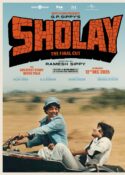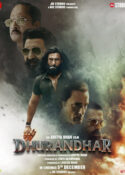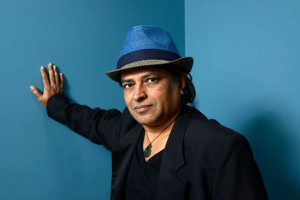 Director Pan Nalin is ecstatic about the response to his latest film, Angry Indian Goddesses, a female buddy movie that won the first runner up prize at TIFF’s Grolsch People’s Choice Awards. He’s taking in all the sights of Toronto, and has been shooting a music video for the film with his seven goddesses for the week. We caught up with Nalin before his world premiere to chat about feminism, funding the film, and his goddesses.
Director Pan Nalin is ecstatic about the response to his latest film, Angry Indian Goddesses, a female buddy movie that won the first runner up prize at TIFF’s Grolsch People’s Choice Awards. He’s taking in all the sights of Toronto, and has been shooting a music video for the film with his seven goddesses for the week. We caught up with Nalin before his world premiere to chat about feminism, funding the film, and his goddesses.
Was this film something that was gestating with you for a while?
Earlier when I did Samsara, and Valley of the Flowers, I did have strong female characters. I did write a couple of story lines, but it wasn’t fully developed. But very soon I realized that in India that it was very nearly impossible to raise any funds. You couldn’t even speak, because they [producers] would say, “Decades ago there was a film like Umrao Jaan and forget it, there’s nothing else to be done.” It’s always a question of we can have great ideas or I believe that it can work, and often we’d argue that it’s not about a woman or man being the hero, it’s a great story! Things change, when a few of the movies become successful, but even to do a female buddy film with so many characters wasn’t possible. Or then we were told if we get big names, so we did try to get in touch with a couple of big names and very soon we realized in 3 calls that they would not act with each other, because they were each other’s worst enemy! Dilip Shankar, who did the casting, was like, “Forget this, we’ll never be able to get 7 of them together.” Every time we were watching and researching, we realized there so many wonderful stories coming out from a college canteen, a workplace, or from friends. It wouldn’t have been possible if Gaurav Dhingra, a man who said, “No, this is great, we’ve got to shoot this.”
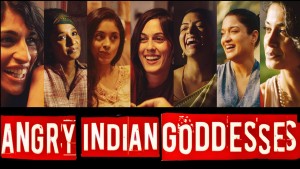 Was it the timing that fell into place in terms Queen or Kahaani doing well, with funding a female-oriented film like this?
Was it the timing that fell into place in terms Queen or Kahaani doing well, with funding a female-oriented film like this?
It was still very tough. It wasn’t that easy, because when something is successful then they want that actress in the film. They think that will make the film a success. They say, “Can you do this film, but put Queen‘s actress and Kahaani‘s actress in it?” So that’s not a good formula, so we knew we couldn’t go that way. We had to spend one or two years to try convince people, but it wasn’t easy. Even when we reached Toronto, we’ve been struggling for financing.
So the film has a great feminist slant to it, was it surprising to others that a man directed this?
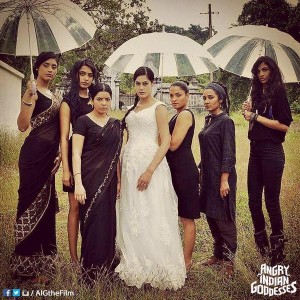 Oh yeah, people were really surprised and even before I made the film. They’d tell me, “Why are you on this suicide mission? 7 women for three months. You’re a dead man!” (Laughs) When the film came out, people have been very surprised. I had to do this but I had to it in a different way, I knew from day one that the casting director, me, and the producer are all men. So there is no way that this is film where you have to script it scene-by-scene and make a schedule like traditional film are made, so we had to create a whole system to incorporate the women’s views and their belief systems. It started with talking to women, bring on women writers, then we had to “meet” these characters. We had shortlisted 12-15 women characters who we thought could be interesting, like struggling Bollywood stars, or CEO, since India has the highest number of women CEOs in the world. So we had a plot line according to these real stories and then all that got really nourished in our storyline as we were auditioning girls. So the auditions weren’t normal that they had to read out a scene and act, for some of them it was like going to a shrink like, “Lie on the couch and open your heart!” (Laughs) So we literally had them crying, but we knew that there were many things which we had not looked upon that should be integrated in the film. We got a lot of good input in creating the group’s believability. Finally, when the seven actresses were found we knew that somewhat half the battle was won, because when we had them together for the first time, it was just magical. Instantly my first feeling was, “I want to be their friends!” And that’s a great success. Our writer, Subhadra too was like, “Two of them are bitches but I still want to be their friends!” (Laughs) So this is what we want people to feel when they watch it, that I know someone like her, or she’s like my sister, mother, etc. So we worked on that idea of being real: the moment you go over the top, the mix of Hindi and English, whether you’re wearing shorts, but just do what your characters would do.
Oh yeah, people were really surprised and even before I made the film. They’d tell me, “Why are you on this suicide mission? 7 women for three months. You’re a dead man!” (Laughs) When the film came out, people have been very surprised. I had to do this but I had to it in a different way, I knew from day one that the casting director, me, and the producer are all men. So there is no way that this is film where you have to script it scene-by-scene and make a schedule like traditional film are made, so we had to create a whole system to incorporate the women’s views and their belief systems. It started with talking to women, bring on women writers, then we had to “meet” these characters. We had shortlisted 12-15 women characters who we thought could be interesting, like struggling Bollywood stars, or CEO, since India has the highest number of women CEOs in the world. So we had a plot line according to these real stories and then all that got really nourished in our storyline as we were auditioning girls. So the auditions weren’t normal that they had to read out a scene and act, for some of them it was like going to a shrink like, “Lie on the couch and open your heart!” (Laughs) So we literally had them crying, but we knew that there were many things which we had not looked upon that should be integrated in the film. We got a lot of good input in creating the group’s believability. Finally, when the seven actresses were found we knew that somewhat half the battle was won, because when we had them together for the first time, it was just magical. Instantly my first feeling was, “I want to be their friends!” And that’s a great success. Our writer, Subhadra too was like, “Two of them are bitches but I still want to be their friends!” (Laughs) So this is what we want people to feel when they watch it, that I know someone like her, or she’s like my sister, mother, etc. So we worked on that idea of being real: the moment you go over the top, the mix of Hindi and English, whether you’re wearing shorts, but just do what your characters would do.
The dialogue felt so improvisational and witty, how was it developing this feel?
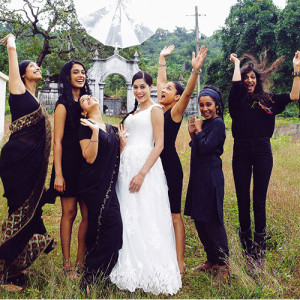 Yeah, so when the characters were developed, each of them developed their style of speaking. They have to perform in a vertical so that they know what their dark side is and what is funny for them or what is normal for them. Like in the case of Pavleen, she had to go through a very tough time because it would be very stupid in her comic scenes. So, she was able to go to Delhi ladies clubs and reference details about how they talk and how they behave. It could be simple gesture like when she says, “Oh mind my hair,” like you’re meeting friends after three years but still that obsession with hair comes up! Another character like Mad, wouldn’t care and would give a full-heart hug. Each one knew their character and within that they had to know the dialogues we had written that they had to adapt and improvise. So it shouldn’t be a literal line that they’re reading, and they were also given the freedom to have a spontaneous reaction, then we’ll choose whether we keep that in the plot. But it has to be within the character, so that constant exercise was reexamine and we would look at the dailies and say, “Maybe you were a bit out of character or she wouldn’t do that.”
Yeah, so when the characters were developed, each of them developed their style of speaking. They have to perform in a vertical so that they know what their dark side is and what is funny for them or what is normal for them. Like in the case of Pavleen, she had to go through a very tough time because it would be very stupid in her comic scenes. So, she was able to go to Delhi ladies clubs and reference details about how they talk and how they behave. It could be simple gesture like when she says, “Oh mind my hair,” like you’re meeting friends after three years but still that obsession with hair comes up! Another character like Mad, wouldn’t care and would give a full-heart hug. Each one knew their character and within that they had to know the dialogues we had written that they had to adapt and improvise. So it shouldn’t be a literal line that they’re reading, and they were also given the freedom to have a spontaneous reaction, then we’ll choose whether we keep that in the plot. But it has to be within the character, so that constant exercise was reexamine and we would look at the dailies and say, “Maybe you were a bit out of character or she wouldn’t do that.”
The film definitely deals with a lot of issues like sexuality, women’s rights, and agency, how did you find that balance?
Definitely, we realized that all these issues had to be character-specific, and whatever we can carry within the character we will talk about.
 The film shifts gears quite a bit in the conclusion, how did you approach showing their angry Indian goddess form?
The film shifts gears quite a bit in the conclusion, how did you approach showing their angry Indian goddess form?
Yeah, that was something we knew we had to earn that kind of climax that we need very strong believable characters. So that when they take their Kali avatar, their ferocious form, I have to buy it. I had seen quite a lot of films, be it mainstream or otherwise, where the moment a woman has to be strong, they start acting like men. For instance, when they’re holding a gun, they hold it like a man or if they fight, they kick like a man would. So this is one thing that came from the women that, “I wouldn’t do it like that or I wouldn’t be heroically brandishing my weapon.” Even the small things like that, they felt destroyed after their actions. So all those subtle details were really important.
The movie is powerful and shocks the viewers, do you hope the film sparks a dialogue around women’s issues.
I really hope so, and they it inspires people. But, I don’t believe movies should have messages, and I don’t like to give a preachy tone, so I try to make entertainment. If you’re entertained, then I feel that a couple of thoughts pass through your head or you feel a bit inspired and your heart will be open. That would be worth it. I even feel that if people are coming to see the film knowing that there are seven women and no man, neither on poster or in it, so for us that’s a big step.
 Were there some differences between the version screened here at TIFF and the Indian one?
Were there some differences between the version screened here at TIFF and the Indian one?
They are slightly different, but the story structure and characters are pretty much the same plot. The main difference is that the Indian version is longer, so there are a couple of additional scenes that we did remove for the international version, because they are so rooted in the Indian ethos and society. So we were not sure if everyone would get this. Something like Section 377, people do realize that ohh there’s this law, which was explained but there were other things that were not so clear so we did remove that. And then Indian version has the intermission, because without an intermission it’s impossible to release a film in India.

